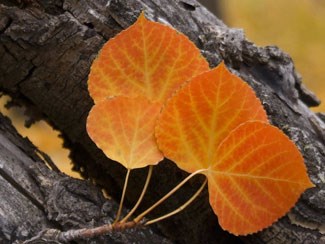
NPS photo by J. Westfall Quaking AspenScientific name (Populus tremuloides) Habitat: 5,600 ft. to 11,000 ft. (1680 m.-3450 m.), montane to subalpine in dry and moist areas. Characteristics: Aspens can reach a height between 30 ft. to 65 ft. Bark is smooth with a color of greenish white with black spots and lines. The leaves are small and densely packed on long slender branches. Fun Facts: Quaking aspens provide beautiful scenery and a rich habitat for wildlife. Aspen, the most widely distributed tree in North America, are one of the few deciduous trees hearty enough to survive in a harsh mountain environment. Aspen trees are short-lived, surviving about 120 years. In mountain environments, the brief and dry growing season often prevents aspen seeds from germinating or seedling from surviving. Instead, an aspen's lateral roots produce vertical shoots, called suckers. Some suckers grow into mature trees, creating a large network of interconnected roots that can produce new trees for over a thousand years! The roots have been shown to exchange resources, such as water and carbohydrates. Flourishing aspens provide shade for young spruce and fir trees. These conifers grow and eventually replace aspen forests. Long after the visible portion of the aspen tree is gone, the underground root system remains behind patiently waiting for a disturbance from fire, avalanche, or other occurrence that removes the conifer forest. If the sun's warmth touches the soil, it will stimulate the aspen's dormant root system, starting another cycle of this pioneering species. 
NPS photo by R. Smith One of the most striking characteristics of the aspen is the beautiful splashes of fall color it adds to the mountainsides. This magical color change starts in early September and can last into October. Weather can dictate a good or poor year for color. Changes in temperature, moisture, and light during fall trigger the breakdown of green chlorophyll in the aspen leaves. As the green color fades, yellow, orange, and red pigments appear. Sunny days and cool nights produce the most dramatic color spectrum. Aspen stands provide a variety of ecosystem services, including soil improvement, watershed protection, wildlife habitat, economic products (mainly pulp), landscape diversity, recreation, and an atmospheric CO2 sink. Species richness and biomass in aspen-dominated forest is considerably higher than in conifer-dominated forest. Narrowleaf CottonwoodScientific name: (Populus angustifolia) Habitat: 7000 ft.-9500 ft., (2100 m.-2850 m.), inhabits bare gravel and sand bars in montanes-riparian (adjacent to streams) areas./p> Characteristics: Narrowleaf Cottonwood can reach a maximum height of 40 to 50 ft. Leaves are slender and tapered. On a single branch the leaves alternate and are simple. The lengths of the leaves are roughly 3 in. to 4 in. long, are light green in color during summer and can become a rich yellow in the fall. Fun Facts: Trees are dioecious, an individual tree is either male or female. Immature trees can be mistaken for a willow; a distinguishing characteristic of Narrowleaf Cottonwood is the limp catkins compared to the erect catkins of willows, and a flattened petiole where the leaf blade meets the petiole (leaf stem). Once they mature, this tree is easily distinguished from other deciduous trees due to its narrow leaves. Narrowleaf Cottonwood is a staple for trout habitat along streambeds and a major food source for Rocky Mountain beavers; seedlings and saplings are stripped of bark for food and larger trees are cut for building material. Native Americans used young cottonwood shoots to make baskets. |
Last updated: May 19, 2018
